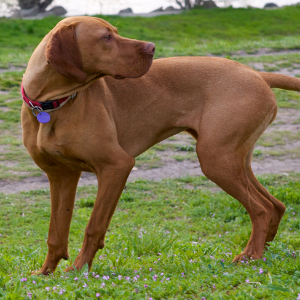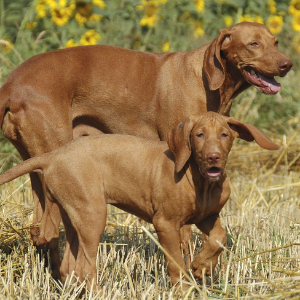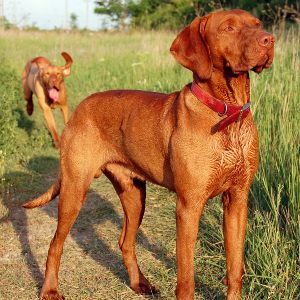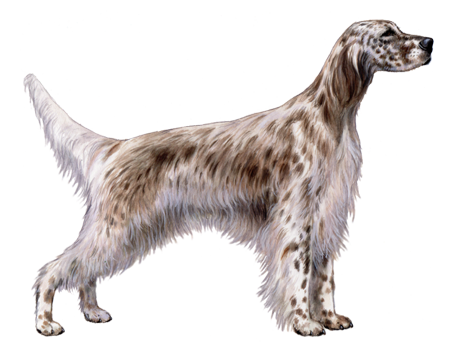
Vizsla
Both a pointer and a retriever, the Vizsla is an energetic, alert, and intelligent breed. It's easy to see why this sensitive, hard-working redhead has been a favorite hunting dog for centuries.
Interested in discovering if your dog is a Vizsla?
Check out Wisdom Panel's DNA tests.

Vizsla Traits
General Appearance
The Vizsla is a medium-sized, lightly built hunting dog with an attractive rust-colored coat.
Coat and Coloring
The Vizsla's coat is short, smooth, and dense. It comes in a variety of golden and red shades, ranging from a light, sandy yellow to a deep red. A small amount of white on the chest is possible. The breed's nose is always liver.
Distinctive Physical Traits
The Vizsla is a lean, muscular dog with a square muzzle and a body that's slightly longer than it is tall. The thin, silky ears have rounded ends and hang close to the cheeks. The color of the breed's medium-sized eyes blends with the color of the coat.
Vizsla Temperament
The Vizsla is an intelligent and energetic breed that loves to learn and please. Devoted and loyal to their families, these dogs are gentle with other animals and kids. Because they prefer to be outdoors, rural environments suit Vizslas best.
Vizslas form very tight bonds with their people and don't like to be left alone for long periods. Though they're typically exuberant around people they know, Vizslas may be shy around strangers.
These dogs have very strong hunting instincts and may chase or hunt wildlife. Vizslas also like to chew. And if not provided with appropriate chew toys, they may take matters into their own paws (and mouths).


Vizsla History
We can trace the Vizsla (also known as the Hungarian Pointer) to the earliest days of Hungarian history—to tribes that inhabited the Carpathian Basin in 1000 B.C.
Vizslas likely descended from the Yellow Turkish Hunting Dog and the now-extinct Transylvanian Hound. Over time, breeders also introduced European dogs to add hunting skills and create the current standard for the Vizsla. One of the oldest known hunting dogs, the Vizsla is actually the ancestor of some of today's newer breeds—such as the Weimaraner and German Shorthair Pointer.
The creation of other breeds and chaos of two World Wars almost led to the Vizsla's disappearance. But the breed bounced back. And now Vizslas serve all over the world as seeing-eye dogs, sniffers for the Transportation Security Administration (TSA), and search and rescue dogs.
Vizslas came to the United States in 1950, and the breed received American Kennel Club recognition in 1960.
Vizsla Care
Nutrition
Vizslas need high-quality food that's appropriate for their life stage (e.g., puppy, adult, senior) and activity level. Because Vizslas can have hearty appetites, keep an eye on your dog's food intake, and reduce meal portions if they become overweight. Also, remember to account for treats in your pup's overall calorie intake. As a guideline, treats should make up no more than 10% of a dog's calories.
Grooming
Vizslas' short coats don't need much in the way of grooming. This breed does shed, but brushing once a week with a rubber grooming brush is usually sufficient. Vizslas don't often need baths unless they roll in something dirty or smelly.
This breed's nails grow very fast. Trim them regularly to prevent them from becoming overgrown. Nails that get too long can cause discomfort or lead to problems walking.
Finally, maintaining good dental hygiene is essential for any dog's long-term health. In addition to scheduling professional dental cleanings, establish an at-home care routine that includes teeth brushing.
Exercise
True to their sporting heritage, Vizslas need a lot of daily exercise. Long walks, hikes, and backyard games of fetch give them opportunities to burn off energy. Vizslas also love to swim and make good jogging buddies.
Other fun options are dog sports—such as flyball, hunt and field trials, agility, tracking, and competitive obedience. These events provide not only physical exercise but also mental stimulation.
Training
The Vizsla is an intelligent, curious breed that's generally easy to train—which is fortunate because untrained Vizslas make difficult housemates. Consistent training, early socialization, and positive reinforcement techniques are the best ways to teach this sensitive breed to behave.

Vizsla Genetic Health Conditions
-
Cerebellar Cortical Degeneration
Cerebellar cortical degeneration (CDD) is a disease causing incoordination and impaired balance.
-
Exercise-Induced Collapse
Exercise-Induced Collapse (EIC) is a neuromuscular disorder which can cause incoordination and weakness, resulting in collapse, after periods of strenuous exercise.
-
Hyperuricosuria
Hyperuricosuria (HUU) is a condition that predisposes affected dogs to the formation of urinary stones, such as kidney or bladder stones.
Knowing if your Vizsla is a carrier or at-risk for these conditions can help you and your veterinarian plan for your pup’s lifelong care. With Wisdom Panel™ Premium, you can get results for over 200 genetic health tests.
Breed Group
Sporting
The sporting group breeds are incredibly diverse in personality and appearance, but can be characterized as very sturdy. They were developed to work closely with people and in general have a very responsive nature and high intelligence.





































































